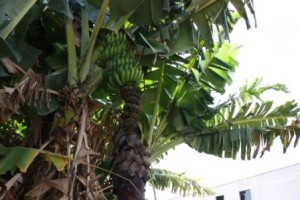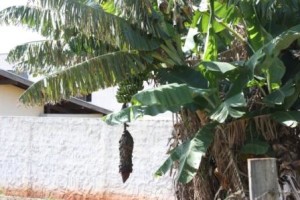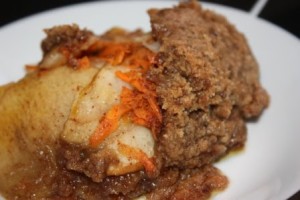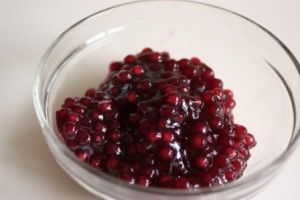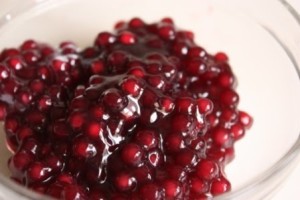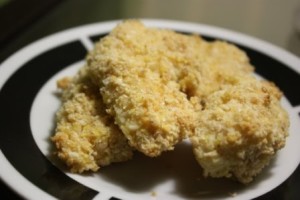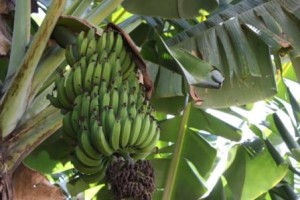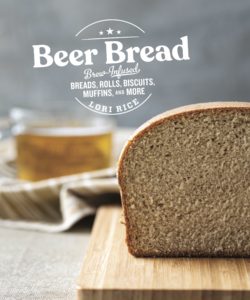Fondue in Brazil
September 4, 2009Fondue? I love fondue. I’m not sure what it is about it. Maybe it is the slow leisurely process of enjoying the meal, the fact that it is a meal I often enjoy with my husband on special occasions, or maybe it is the food. Yes, the actual food ranks high on the list.
In the US our fondue experience has been limited to Melting Pot. We still enjoy that restaurant very much, but we have found a rather outstanding substitute here in Brazil.
I may have mentioned it before, but in the city we live in right now, food variety is limited. Sure there are lots of great Brazilian foods and even Japanese for that matter, but you won’t find a lot of cultural variety.
Curitiba, one of my favorite cities, is a completely different story. There you can find foods from just about every culture of the world and we take full advantage when we are visiting. On one of our first visits a friend told me about a great fondue restaurant, Chateau de Gazon. It was love at first bite and we’ve been back each trip since. We celebrated our anniversary there, my husband’s birthday and even no special occasion at all.
The fondue here is different, but in a very good way. However, those who fear they may miss the Brazilian cultural influences by eating at a fondue restaurant need not fear; there is a purely Brazilian twist in many ways.
I’ve been to a couple different fondue places in Brazil and it appears that using oil to cook the meat is the most popular option. I’m not a big fan of this and the broths seem hard to come by, but at this particular restaurant they have a great variation – na pedra – or a small stone grill they bring to your table. See, I told you there would be Brazilian twists all over the place.
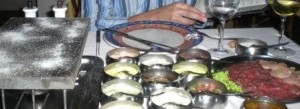
We always have to start with the cheese fondue, of course. It’s served with bread, broccoli, carrots and mini-potatoes. I haven’t been able to figure out exactly what cheese they use here, but it has a mild flavor and pairs nicely with the bread and vegetables.
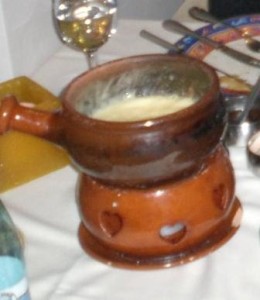
The meat usually consists of beef and chicken, sometimes there is lamb as well. It is cut into small pieces and pounded very thin so that it cooks quickly on the small grill. Along with the meat comes one of the best parts, the sauces! Thirteen total. From the Brazilian side of things you get farofa (toasted cassava flour), vinaigrette (chopped veggies tossed in lime juice), rose sauce (ketchup, mustard and mayo; not a favorite) and chopped eggplant in oil. To round that out there is spicy mustard, curry mayo, gorgonzola, onion marmalade, orange marmalade and a few more that we can never fully identify. I want to eat more meat just to try all the sauces!
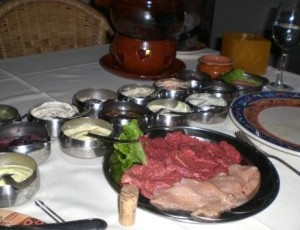
The dessert course offers all the tropical goodness of Brazil – seven different types of chopped fruits. You get melon, papaya, strawberries, pineapple, banana, apple and grapes. With that there is typically marshmallows and one time we even got little wafer cookies.
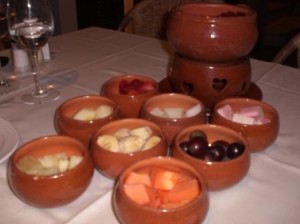
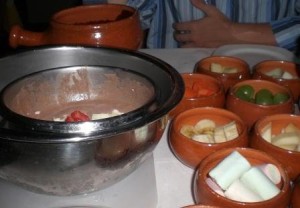
The chocolate is of the dark variety and goes so well with all the fruit. The second time we went they started adding an extra dipper to the dessert. In addition to the chocolate we got a bowl of half melted ice cream to dip our fruit in. I wasn’t a huge fan of this. I guess I just find it difficult to get excited about melted ice cream. On our most recent visit, though, they pulled out the ultimate offering. Along with the chocolate we got a bowl of warm doce de leite! With each piece of fruit I speared I was faced with the difficult decision of which one to dip it in, they were both equally fantastic.
To sum up, fondue in Curitiba is a must. In fact, Curitiba in general is a must. If you ever plan a trip to Brazil you’ll likely get a lot of advice on where to go. My vote? Do not miss this great city. I’ve thought a lot about why it is so appealing to me. In addition the diversity and some of the best food I’ve eaten in Brazil, it is also that the city is manageable.
I travel a lot with my husband when he works and that means I’m out and about on my own much of the time. There are lots of great cities here in Brazil, but to be honest, I would not feel courageous enough to tackle many by myself mainly due to their size. I don’t feel that way with Curitiba at all. It is a city of about 1.8 million and it is the ideal size for exploring alone or with a partner. It’s full of parks and historic attractions, not to mention shopping malls and small boutiques. When you combine all of that with outstanding food you’ve got one great travel destination.
Where to find the fondue:
Restaurant Chateau de Gazon
Rua Pasteur, 134 – Batel
Curitiba – PR, Brasil
www.chateaugazon.com.br
Feasting on Pine
September 3, 2009For a tropical country Brazil has some impressive evergreen trees, at least in the mountainous regions of the country. In fact, the claim-to-fame of the state we are living in is the majestic Araucaria tree. There are about 19 different types of Araucaria tree and each looks just a little different.
While some varieties can be found in other parts of South America, the type the state of Paraná is known for is the Araucaria angustifolia. It is also sometimes called the pinheiro-do-paraná (the Paraná pine). There are a few where we are living, but many more in Curitiba, about a 6 hour drive away, towards the coast. They can also be found in a few states north and south of here such as in Santa Catarina where the island of Florianopolis is located.


The trees have different shapes, but I love the ones that are more flat along the top. The branches extend out to make them almost look like a candelabra.
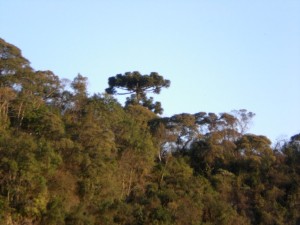
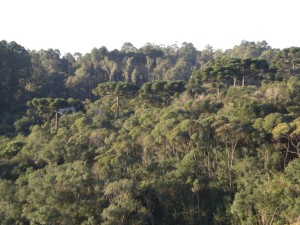
So what does all this talk about trees have to do with food?
Well, the pine nuts from the Araucaria tree can be eaten and happen to be quite popular around the area.
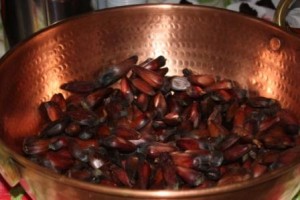
Typically available from May through July (winter), the pine nuts, or pinhão, are most often associated with Festa Junina events. This June festival celebrates rural life and is often equated to a hillbilly party. The hillbillies, so-to-speak, are referred to as Caipiras, a term which lends to the name for the popular Brazilian cocktail, caipirinha. Foods such as canjica, peanuts and popcorn are served at these parties as well as pinhão.
In addition, you can also find the nut in the supermarkets during this time of year. If you happen to be on a road trip like we were in late April you will also pass plenty of roadside stands selling cooked pinhão by the bag. The pine nut (still in it’s shell) is prepared most often using a pressure cooker and is seasoned with salt. It is also made into a soup, but I haven’t had the opportunity to try it.
When we were at the Curitiba Zoo last fall we were able to read a translated description of the pine nut including details about its nutritional value – rich in vitamin B, calcium, phosphorus and protein.
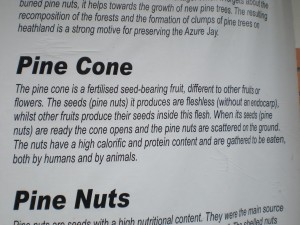
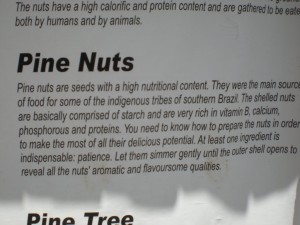
The pinhão are quite difficult to get into. Our friends here suggest biting off the end, spitting it out and then pushing the nut out with your fingers. We tried this, but I always ended up having to peel it.
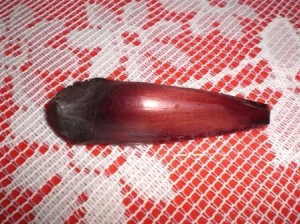
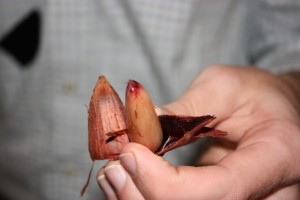
The texture and flavor are like a cross between a nut and firm bean which is enhanced by the added salt. It is a great snack, but given the difficulty of getting one open only a handful tend to be consumed at a sitting.
This has most certainly been one of those local foods we won’t be experiencing anywhere else anytime soon. Even parts of Brazil aren’t fortunate enough to enjoy this winter treat. The pinhão and the Araucaria tree are big foodie benefits of living in Paraná.
Apple, Carrot and Pear Crisp
September 2, 2009Apple, Carrot and Pear Crisp
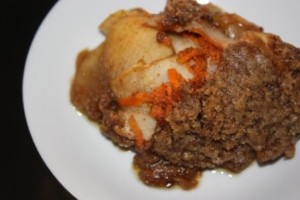
1 tsp. butter
¾ cup carrot, shredded
2 tsp. cinnamon, divided
2 pears, sliced
2 apples, sliced
½ cup mascavo sugar
1 tbsp. flour
½ cup oats
¾ cup mascavo sugar
¾ cup whole wheat flour
¼ cup walnuts, chopped
¼ tsp baking soda
½ cup butter
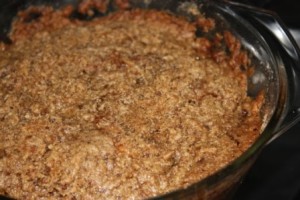
Links to a Healthy Weekend
August 29, 2009Sagu de Vinho #24
August 28, 2009Most of the Brazilian recipes I Google pop-up on the first search page, but for Sagu I had to do a little more digging. I’m not sure if it has to do with the popularity of this dish, or that maybe it is more regional to the area we are living in. I say this because I happened to mention it to my host during my visit to Minas Gerais and she hadn’t heard of it before.
Sagu is basically tapioca pearls. It is served as a dessert around here and you can often find it among other sweets on per kilo buffets (which are the normal lunch for many Brazilians). Sagu can be made with only juice. However, I prefer the version made with juice and wine.
My husband’s coworkers have joked before that they loved it as kids when their grandmothers made Sagu because it meant they got to have a little wine. Although, considering the cooking process, I doubt there is much alcohol left in the final dish.
Sagu reminds me a lot of a jello salad (without all the artificial ingredients). The pearls become slightly chewy and the cooking process turns the liquid into a thick sweet sauce that has an intense tangy flavor from the concentrated wine. It’s good at room temperature or cold, but after it gets cold the pearls and sauce really solidify so it does become thicker and a bit sticky.
Since having Sagu out at restaurants I wanted to try it myself at home which is why I made it #24 on my 30 Foods List. Like most culturally specific foods there are different recipes for making it. Some cook the sagu in water before adding the wine or juice, others also include cinnamon and clove for flavoring. Me, well, I just followed the recipe on the back of the bag of tapioca pearls.
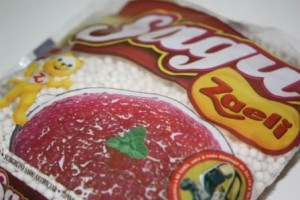
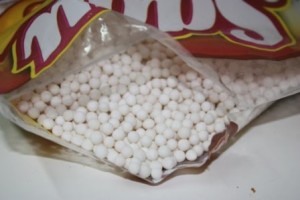
I think we’ve established that desserts in Brazil are sweet, really sweet. So it’s no surprise that in addition to a liter of juice the recipe calls for 2 cups of sugar! You’ll be happy to know that I left that out. I used ½ juice and ½ table wine, and knowing the juice had some sugar in it to begin with I knew it would be sweet enough for me and it was.
I think you should be able to get your hands on tapioca pearls in the States pretty easily so if you are looking for something a little different for dessert, give Sagu de Vinho a try.
1 cup tapioca pearls
½ liter grape juice
½ liter red table wine
Add all ingredients into a medium to large soup pot. Cook over low heat until the pearls become transparent and are cooked through, about 30 to 45 minutes.
A note to San Francisco readers and those headed to the Foodbuzz Fest:
I’m headed to the event and will be in the area for an extended period. If you want to meet up at some point to talk food, health and culture let me know!
Simple Coconut Chicken
August 26, 20091 cup coconut milk
1 ½ cups bread crumbs (your choice – panko, whole wheat, gluten free)
1/3 cup flaked coconut
½ tsp salt
¼ tsp black pepper
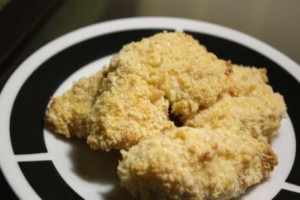
Do you have any past recipes that you loved, but have completely forgotten about? Or am I the only one who can’t seem to keep my recipes straight?
Pots, Pans and Foodie Souvenirs
August 24, 2009First let me say I’m sorry about the lack of a Link’s post this past weekend. My travel, an unexpected cold bug and my husband’s return from a business trip to the Dublin area made for less than normal weekend. I haven’t been away from the computer, but I’m starting to feel the pressure of the upcoming Southeast Asia trip so that is taking up much of my time at the moment. Wow, do I have a lot more research to do about what to see and where to eat!
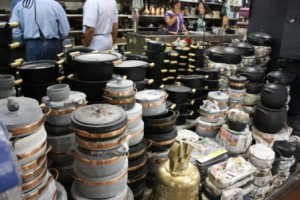
Where we are living in there isn’t a whole lot of this traditional cookware. We do get bamboo cooking utensils which I love, but pots and pans are more modern. This artisanal cookware was an exciting find, but it took me a long time to decide if I was going to lug back a pot. These suckers are heavy! I just had to take my chances though because I know I will likely not have the chance again.
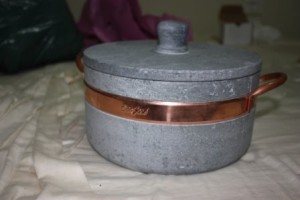
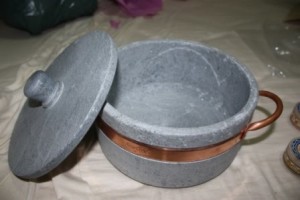
The pot will turn black after I treat and seal it. Everyone tells me that it will keep hot food hot for about 4 hours and you can even use it with cold salads and it will similarly keep the food cold for an extended period. I’ll be sure to share the first meal I cook in it. I haven’t quite decided what that will be yet.
I only wish I could have brought back more. This pot I found at the central market in Belo Horizonte, but in Ouro Preto they had so many things made out of soap stone – soup bowls, wine holders/chillers, base plates and vases. I did manage to bring back a few carved soap stone boxes for Christmas gifts. Sorry for the spoiler if any of my family is reading!

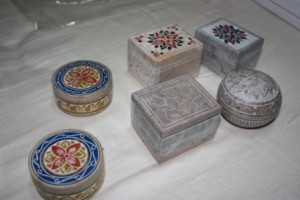
Now on to the edibles.
Minas has a lot of the same doces (sweets) that we have where we are living, but as I mentioned in my last post most are in a more liquid, scoop-able from. Just about every stall in the central market had a huge case full of sweets like this.
It included doce de leite, cocada, a combination of the two, chocolate doce de leite, guava fruit jam (goiabada) and many candied fruits like mamão and fig. And, oh yes, you get to taste any that you want.

Then there are all kinds of packaged foods you can pick up like this doce de leite wrapped in little corn husks. The actual doce de leite isn’t much to write home about, but the package makes it way too attractive to pass up. Next, I picked up some packaged candy, similar to a fudge that combined a very lightly cooked doce de leite and firm guava fruit jam.
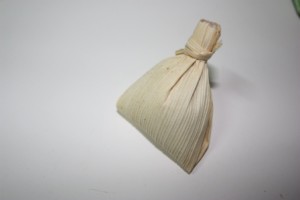

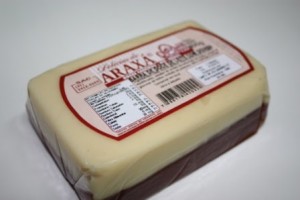
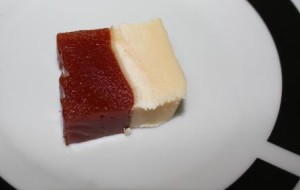
I also brought back a sample bottle of Vale Verde cachaça (a brand made outside the Belo Horizonte) and a sample of the Jabuticaba liqueur so my husband could give it a try.
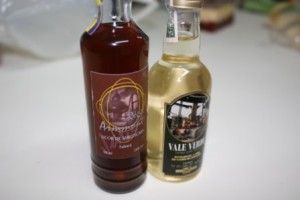
With all this sweet, something savory had to be included and that something was Canastra cheese. Most of us in the other states of Brazil are familiar with cheese from Minas because it is so well known across the country. I can always find Minas Frescal in the supermarket here which is a fresh, cow’s milk cheese. However, once it is matured Canastra cheese is created and what makes this special is that it is a regional cheese specific to Minas Gerais and the Serra da Canastra. If you want to read a little more you can check out this book excerpt from Brined Cheeses by A.Y. Tamime.
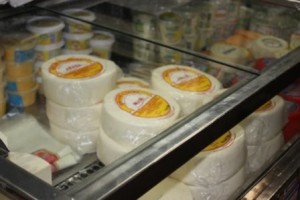
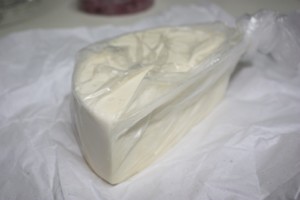
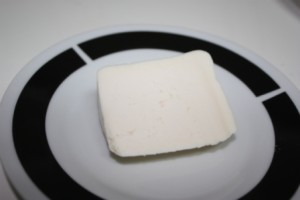
It is a soft, velvety cheese that immediately melts in your mouth. In my opinion it is similar in texture, but slightly firmer than, fresh mozzarella, but with a much sharper flavor. I brought a half wheel back, a little less than a kilo. I seriously can’t stay away from it. I keep trying to make it last, but every time I open the fridge door, there it sits. My favorite way to enjoy it is slightly melted over bread with goiabada.
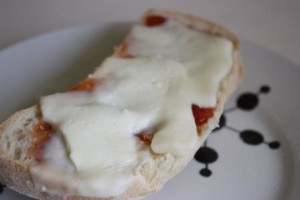
After all this, you can imagine the luggage was quite heavy. It was a truly amazing food culture experience and I have plenty to remind me of it now that I’m back home.
Fortunately, this weekend the food party didn’t end there. I can’t finish this post without telling you about the goodies my husband brought back from Ireland to share with me. You see, I’ve been to Ireland with him the past two years and this year we decided I would skip out so we could put the funds towards our SE Asia trip. But even that trip and my wonderful trip to Minas Gerais didn’t leave me completely without disappointment that I failed to make it to Europe this year so my husband was there to help.
Guinness chocolate, toffees and fudge were part of the spread along with some Jameson to keep the liquor cabinet full until we depart in a month. He flew KLM so they had these amazing caramel wafers from the Netherlands via duty free. We first had these in either Vienna or Munich and they are amazing. A very thin wafer filed with salty caramel. We have found them at specialty stores every now and then in Lexington, but it has been a while.
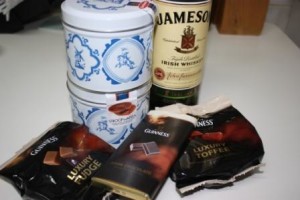

Finally he packed back Bulmers!! This is my absolute favorite cider. It can also be found under the name Magners. Carbonated, fruity and crisp it is perfect for summer, but so good that it can’t be passed up even on the coolest or rainiest days while in Ireland. He picked up a couple of the pear flavored to try something different. It was good, but I have to say the original is the best.
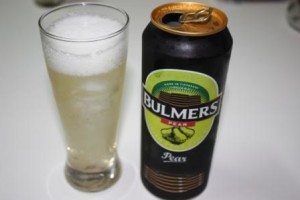
So there you have it, foodie finds from around the world! This week I have some recipes lined up and I hope to get back to regular cooking if I can kick this cold to the curb. Thanks for walking back down memory lane with me through my trip recap. I hope you found something you enjoyed among all this great food!
Foods of Minas Gerais
August 20, 2009 Remember when the Internet was an incredibly scary place? When people would warn about being too visible and you felt as though you had to sneak around for fear that it was a world full of only the weird and unstable.
Remember when the Internet was an incredibly scary place? When people would warn about being too visible and you felt as though you had to sneak around for fear that it was a world full of only the weird and unstable.
I’m so glad those days are gone! I mean, you still have to be careful, but the world of blogging, travel and food has been a wonderful thing. From the day I started my ex-pat blog, which expanded to this blog, I began meeting people; friendly, real people.
For the last few days I’ve been taking advantage of one of those connections I’ve made. Someone who reads my ex-pat blog invited to me to visit Belo Horizonte and Ouro Preto in Minas Gerais, Brazil. Not only did I get to meet her and her family, I also got to meet another ex-pat family living there.
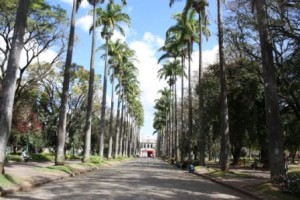
It was a wonderful trip filled with lots of history, a part of this country that I was sorely lacking. This included a history of both food and some things related to cooking. It was such a great experience to try some new foods, and some of the foods I’m familiar with prepared in a different way.
I thought I’d first share with you some of the best meals I had highlighting those things that are specific to that area of the country. In my next post I’ll expand to some of the food and cooking related goodies I got including those from the central market.
Before my trip everyone kept telling me that Minas food is very different. Looking back, I wouldn’t say it is very different because many of the same ingredients are used here. However, there were some dishes that I was able to taste for the first time, some of which I’ve never seen on the menus in Maringá, or at least I didn’t know them well enough to order them and they aren’t that visible on the tables around us.
While I was in Belo Horizonte we took a trip to Ouro Preto, a city I’ve been interested in since seeing a documentary on it before our move. It is only about 1.5 hours away so a great option for a day trip.
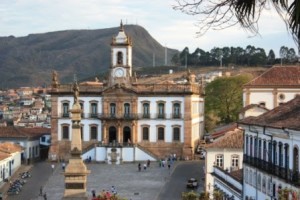
This place holds much of the history of the country and if you travel to Brazil I’d highly recommend making your way there. Yes, I’d even suggest skipping a few days at the beach for it. It was simply amazing with cobblestone streets, village-like architecture, historic museums and churches filled with ornamental gold-leaf. It reminded me a lot of Prague and it is where much of the gold mining was done for that which was then sent to the Portuguese Crown.
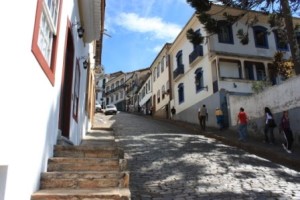
While I learned about the history, I’m not the best at creating the written word to capture it for an interesting story. If you want to learn more, head over to the Salty Cod. Mallory recently visited and has an extensive post about the history of the city and some amazing photographs.
It was in Ouro Preto that I got to try food that is specific to Minas Gerais. I was interested to learn from Emily, one of the U.S. ex-pats I visited there, that the food is very similar to that which we find in the southern U.S. It makes sense due to both areas having a strong African influence.
For lunch we went to Chafariz, a somewhat touristy spot which specialized in Minas cuisine. When I use the word touristy I mean that to say that a lot of Brazilian tourists eat there and you can find it mentioned on travel guides like Frommer’s. I don’t mean it to say it has been altered to be appealing to a variety of tastes like many touristy establishments. This is the authentic version for sure.
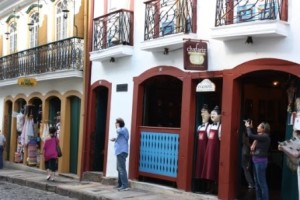
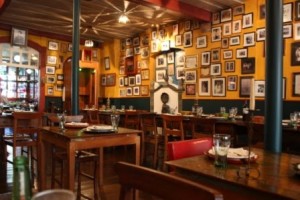
We started with a small shot of local cachaça that came with the meal. You know I’m not a huge fan of it, but this variety was actually pretty good. It was followed by Caldo Verde a soup found in both Portuguese and Brazilian cuisine. It has a thick broth and is filled with couve (collard greens), potatoes (usually mashed into the broth) and pork or pork sausage. It was also served in soap stone bowls which I will explain more about in my next post.
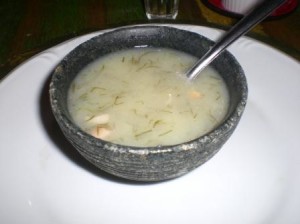
I have had this soup before and the one we had at Chafariz was one of the best I’ve tried. I have attempted to make it before, but I can’t get it quite right. You can check out this recipe from Pink Bites if you are interested in trying it yourself.
My goal was to try everything new to me, or that was prepared in a way I was unfamiliar with. Well, except for rice and farofa. A Brazilian meal just wouldn’t be complete without those. I did pretty well on the first plate, but I did have to go back for a tiny follow up to get it all in.
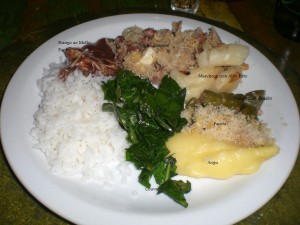
The first thing that caught my attention when the cuisine was being explained to me was Frango ao Molho Pardo (chicken in brown sauce which is actually blood sauce). This was very good, kind of like a beef stew with chicken. I have to admit the thought of the blood does bother my mind-to-stomach system after I think about it for a while, but I wanted to try it out and I’m glad I did.
I’d read about Frango com Quiabo (chicken with okra) after we first moved and while I’ve seen okra on some occasions at the market, this dish doesn’t stand out in Maringá. I was looking forward to the opportunity to try it. The way the okra is cooked makes it tender, but allows it to maintain a slightly firm texture without being mushy and the seasonings are outstanding. By far the best way I’ve had okra.
Feijão Tropeiro was a combination of beans, farofa, fried egg, garlic, onion, bacon and sometimes sausage though I’m not sure I got a piece of that in my taste. Each ingredient is cooked separately and then combined so each holds its own shape and texture. No mushy stuff here. I loved this. It was my kind of all-in-one dish. It is often equated to trail food or cowboy food. Just to pass on the history lesson I received the tropeiro was used to take the gold from Ouro Preto into other areas of Minas Gerais and the whole process was executed through the use of donkeys and mules.
The other things on my plate included angu (polenta, more of a cornmeal mush) and couve which was sautéed with garlic. I really like the couve this way because it changes the bitterness compared to the fresh couve often served and gives it a more complex flavor. I’m not a big fan of the polenta because it is cooked in such a way that it is more of a sticky paste. Then I couldn’t pass up the steamed mandioca com alho frito (fried garlic) because I love the flavor of the fried garlic.
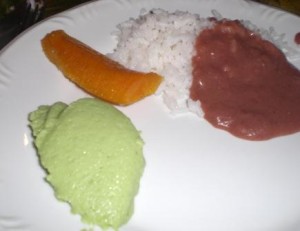
My second trip I got very little because I just to try out what I missed the first time. The bean paste is Tutu à Mineira which is similar to refried beans and has been mixed with mandioca flour. It has a sticky, pasty taste similar to the polenta. The interesting green fluff is Mousse de Pepino (cucumber). I’ve never had anything quite like this before. It had that refreshing taste that you’d expect from a cucumber and a slightly grainy texture. It was a unique flavor, but for me, only good in small doses. I rounded out the plate with a slice of cooked banana.
The doces (sweets) in Minas are similar to what we have here, but they are often served in a more liquid, scoop-able from. Therefore, you will find bowls full of doce de leite, cocada (coconut with sweetened condensed milk), candied fruits like the fig I have there (the green stuff) and they also serve the goiaba (guava fruit) in a candied jam form or in a solid form with a gritty texture. This variety is also served with local cheese. Of course, there is little I can fault with the sweets.
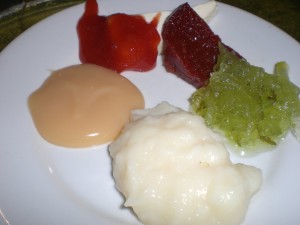
The meal was followed up with a cafezinho (strong, dark coffee) and a small taste of local Jabuticaba liqueur.
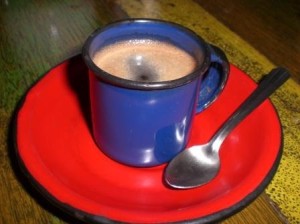
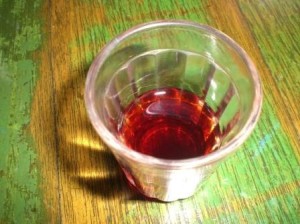
I don’t think I’ve talked about Jabuticaba before. It is a small, dark purple fruit, a little larger than a concord grape. The outside skin is smooth and shiny, inside is a white, opaque pulp with a fairly large seed. Its textures are very similar to a wine grape, but the flavor is simply sweet. It isn’t distinct to me, just sugary sweet and the liqueur was the same way. We can buy it (and grow it) here, but I don’t even think I’ve taken the chance to get a picture of it. Hopefully the Wikipedia page will help.
Links to a Healthy Weekend
August 15, 2009Don’t (White) Sugar-Coat It had a post about a recent visit to the farmer’s market which featured a Brazilian vegetable that I haven’t had yet. The Maxixe is a small cucumber with a lemon flavor. I have seen this name before (although I think it may have been spelled differently), but haven’t branched out to purchase some. Just the other day I read about the lemon cucumber and had no idea that it might be the same thing. They are going in my bag if I can find them again!
